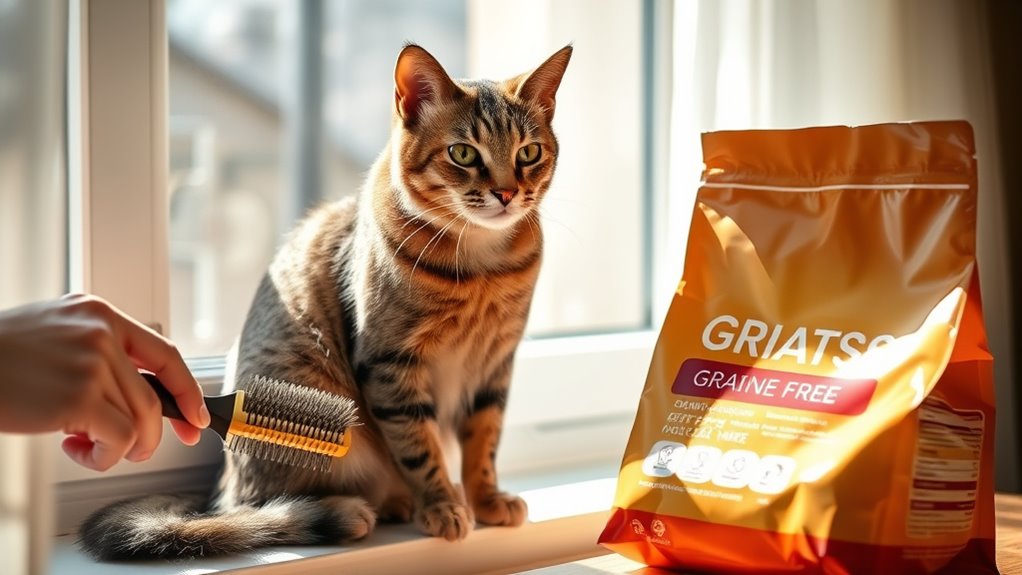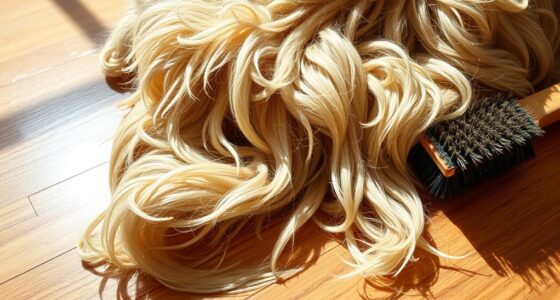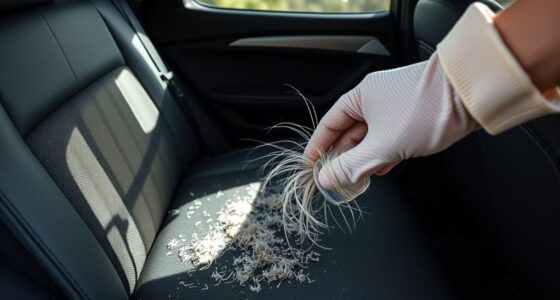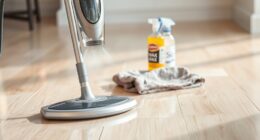To reduce cat shedding, focus on feeding a balanced diet rich in omega fatty acids, antioxidants, and vitamins like E and biotin, which improve skin and coat health. Regular grooming, especially daily brushing, helps remove loose hair before it falls and decreases hairballs and dander. Combining proper nutrition with consistent grooming not only keeps your home cleaner but also supports your cat’s overall health. Keep exploring for more tips to manage shedding effectively.
Key Takeaways
- Provide a balanced diet rich in omega-3, omega-6, antioxidants, vitamin E, and biotin to promote healthy, less shedding fur.
- Brush your cat daily with suitable tools to remove loose hair before it falls around the house.
- Regular grooming reduces hair ingestion, decreasing hairballs and minimizing shedding-related messes.
- Grooming helps remove dander and skin flakes, lowering airborne allergens and allergy symptoms.
- Combining proper nutrition and consistent grooming supports a healthy coat, reducing excess shedding and dander.
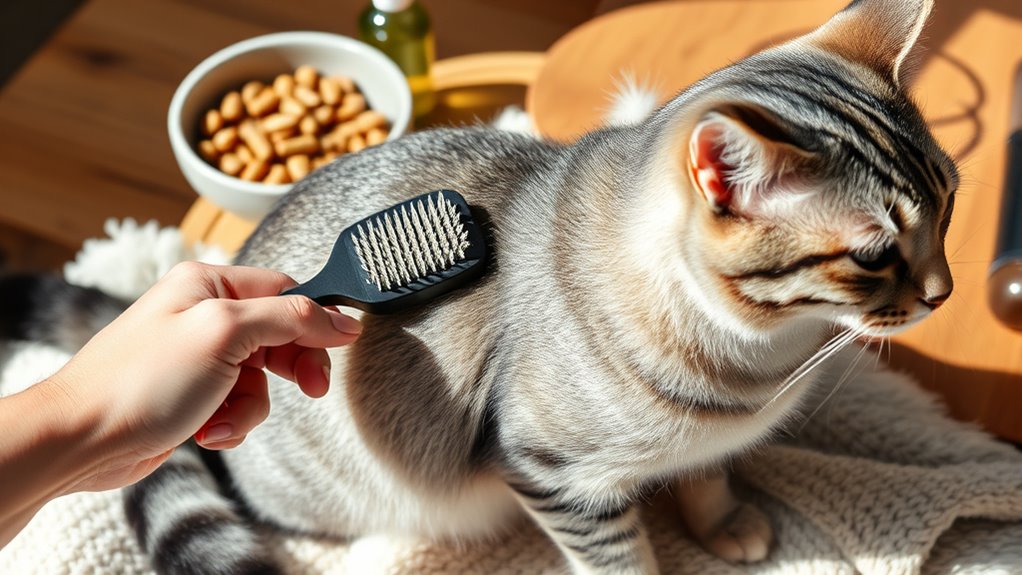
If your cat is shedding more hair than you’d like, there are practical steps you can take to reduce the mess. One of the most effective ways is through proper diet and grooming. A balanced diet rich in omega-3 and omega-6 fatty acids can considerably improve your cat’s coat health, leading to less hair falling around the house. When your cat consumes high-quality food, their skin stays hydrated, and hair follicles become stronger, naturally shedding less. Additionally, foods containing antioxidants and vitamins like E and biotin support healthy skin and fur, which directly contributes to reducing excessive shedding.
Regular grooming plays an essential role in managing shedding and maintaining a tidy home. Brushing your cat daily with a suitable grooming tool helps remove loose hair before it falls to the floor or furniture. This not only cuts down on the amount of hair shed but also stimulates blood circulation and distributes natural oils across the coat, resulting in a shinier, healthier fur. For long-haired cats, daily brushing is especially indispensable to prevent matting and to keep hairballs at bay. When you remove loose hair regularly, you also lower the risk of hairball formation, which is a common concern for both you and your feline friend.
Daily grooming prevents matting, reduces hairballs, and keeps your cat’s coat shiny and healthy.
Proper grooming also supports hairball prevention. Hairballs form when your cat ingests loose fur during grooming and it accumulates in their stomach. By brushing more frequently, you lessen the amount of loose hair your cat swallows, thereby reducing hairball incidents. This is particularly helpful for cats prone to hairballs, as fewer ingested hairs mean less discomfort and fewer messy incidents around your home.
In terms of allergy management, grooming is equally advantageous. Cat dander, which triggers allergic reactions, often clings to loose hair and skin flakes. Regular brushing helps remove these allergens from your cat’s coat, minimizing airborne particles and reducing allergy symptoms in sensitive individuals. Alongside grooming, feeding your cat a diet that promotes healthy skin and coat can also help. Healthy skin produces fewer flakes and dander, making it easier to manage allergies.
Frequently Asked Questions
Can Supplements Help Reduce Cat Shedding Effectively?
Yes, supplements can help reduce your cat’s shedding effectively. By improving their diet with omega-3 fatty acids and other nutrient-rich supplements, you support healthier skin and a shinier coat. The benefits include less hair loss and fewer hairballs. Incorporate these supplements alongside a balanced diet to enhance your cat’s overall coat health. Consistent use can make a noticeable difference in shedding and coat quality over time.
Are There Specific Grooming Tools Recommended for Shedding Control?
You should use deshedding shampoos and grooming tools designed for shedding control, like wide-tooth combs or slicker brushes. Regular grooming, about 2-3 times weekly, helps remove loose fur before it sheds around your home. Incorporate deshedding shampoos during baths to loosen and remove dead hair effectively. Consistent grooming not only controls shedding but also keeps your cat’s coat healthy and shiny.
How Does Water Intake Influence a Cat’s Shedding?
Surprisingly, water intake can markedly influence your cat’s shedding. Better hydration levels help keep their skin and coat healthy, which can reduce excessive shedding during shedding cycles. When your cat drinks enough water, it supports natural oil production and skin elasticity, leading to less loose fur around the house. So, while it might seem trivial, ensuring proper hydration actually plays a vital role in managing your cat’s shedding.
Do Certain Breeds Shed Less With Diet Changes?
Yes, certain breeds shed less due to breed differences, but dietary impacts can also help. You can reduce shedding by choosing high-quality foods rich in omega-3 and omega-6 fatty acids, which promote healthier, less brittle fur. While some breeds naturally shed less, a well-balanced diet supports your cat’s coat health overall. Tailoring diet changes to your cat’s breed and needs can make a noticeable difference in shedding.
Is Over-Brushing Harmful to Cats’ Skin Health?
Over-brushing can harm your cat’s skin, leading to irritation in about 30% of cats. Excessive grooming strips natural oils, causing dryness and discomfort. You should aim for a grooming frequency that suits your cat’s breed and skin type, typically once a week for short-haired cats and more for long-haired ones. Always watch for signs of skin irritation, and adjust your brushing routine to keep your cat comfortable and healthy.
Conclusion
Think of your cat’s shedding as a garden in need of regular tending. Just as pruning and watering keep plants healthy and lush, a good diet and grooming help your cat’s coat stay strong and shed less. By nurturing your feline like a gardener tends to a cherished flower bed, you’ll create a vibrant, manageable coat that blooms with health. With patience and care, your home becomes a sanctuary where your cat thrives, shedding less and shining brighter.
